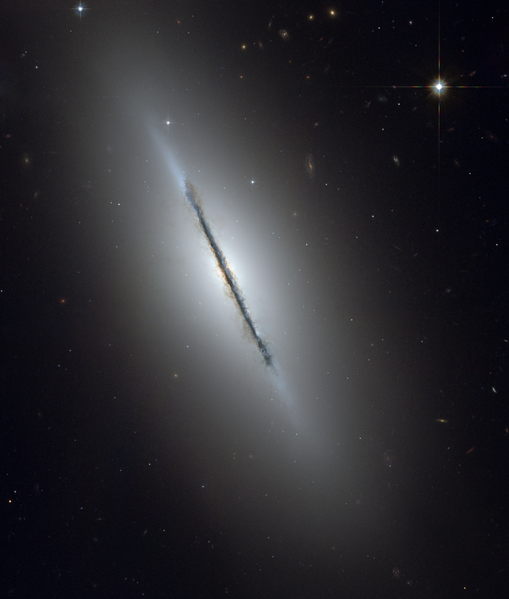চিত্র:Ngc5866 hst big.png

এই প্রাকদর্শনের আকার: ৫০৯ × ৫৯৯ পিক্সেল। অন্যান্য আকারসমূহ: ২০৪ × ২৪০ পিক্সেল | ৪০৮ × ৪৮০ পিক্সেল | ৬৫২ × ৭৬৮ পিক্সেল | ৮৭০ × ১,০২৪ পিক্সেল | ১,৭৩৯ × ২,০৪৮ পিক্সেল | ৩,১৯০ × ৩,৭৫৬ পিক্সেল।
মূল ফাইল (৩,১৯০ × ৩,৭৫৬ পিক্সেল, ফাইলের আকার: ২৫.৭৮ মেগাবাইট, এমআইএমই ধরন: image/png)
ফাইলের ইতিহাস
যেকোনো তারিখ/সময়ে ক্লিক করে দেখুন ফাইলটি তখন কী অবস্থায় ছিল।
| তারিখ/সময় | সংক্ষেপচিত্র | মাত্রা | ব্যবহারকারী | মন্তব্য | |
|---|---|---|---|---|---|
| বর্তমান | ১৮:৩৮, ১৬ ফেব্রুয়ারি ২০০৯ |  | ৩,১৯০ × ৩,৭৫৬ (২৫.৭৮ মেগাবাইট) | Spencer | {{Information |Description={{en|1=From original NASA press release: :This is a unique view of the disk galaxy en:NGC 5866 tilted nearly edge-on to our line-of-sight. Hubble's sharp vision reveals a crisp dust lane dividing |
ফাইলের ব্যবহার
নিম্নলিখিত পাতাটি এই ফাইল ব্যবহার করে:
ফাইলের বৈশ্বিক ব্যবহার
নিচের অন্যান্য উইকিগুলো এই ফাইলটি ব্যবহার করে:
- ab.wikipedia.org-এ ব্যবহার
- ace.wikipedia.org-এ ব্যবহার
- af.wikipedia.org-এ ব্যবহার
- af.wikibooks.org-এ ব্যবহার
- af.wikiquote.org-এ ব্যবহার
- af.wiktionary.org-এ ব্যবহার
- ak.wikipedia.org-এ ব্যবহার
- als.wikipedia.org-এ ব্যবহার
- am.wikipedia.org-এ ব্যবহার
- am.wiktionary.org-এ ব্যবহার
- ang.wikipedia.org-এ ব্যবহার
- ang.wiktionary.org-এ ব্যবহার
- an.wikipedia.org-এ ব্যবহার
- an.wiktionary.org-এ ব্যবহার
- arc.wikipedia.org-এ ব্যবহার
- ar.wikipedia.org-এ ব্যবহার
- ar.wikibooks.org-এ ব্যবহার
- ar.wikinews.org-এ ব্যবহার
- ar.wikiquote.org-এ ব্যবহার
- ar.wikisource.org-এ ব্যবহার
- ar.wikiversity.org-এ ব্যবহার
- ar.wiktionary.org-এ ব্যবহার
- arz.wikipedia.org-এ ব্যবহার
- ast.wikipedia.org-এ ব্যবহার
- ast.wiktionary.org-এ ব্যবহার
- as.wikipedia.org-এ ব্যবহার
- av.wikipedia.org-এ ব্যবহার
- ay.wikipedia.org-এ ব্যবহার
- ay.wiktionary.org-এ ব্যবহার
- az.wikipedia.org-এ ব্যবহার
- az.wikibooks.org-এ ব্যবহার
- az.wikiquote.org-এ ব্যবহার
- az.wikisource.org-এ ব্যবহার
- az.wiktionary.org-এ ব্যবহার
- bat-smg.wikipedia.org-এ ব্যবহার
- ba.wikipedia.org-এ ব্যবহার
- bcl.wikipedia.org-এ ব্যবহার
- be-tarask.wikipedia.org-এ ব্যবহার
- beta.wikiversity.org-এ ব্যবহার
- be.wikipedia.org-এ ব্যবহার
এই ফাইলের অন্যান্য বৈশ্বিক ব্যবহার দেখুন।